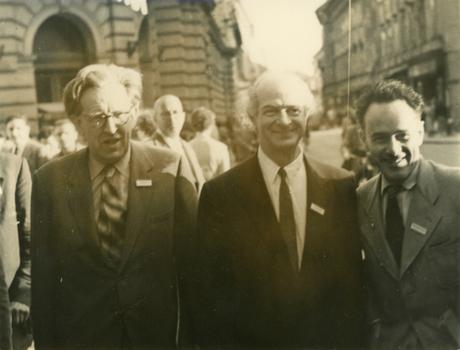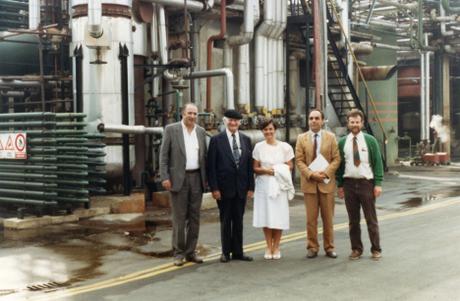
J.D. Bernal, Linus Pauling and an unidentified individual in Ljubljana, Yugoslavia, 1957.
[Part 1 of 2]
On October 11, 1991, an appeal appeared in The New York Times containing Linus Pauling’s name and a brief description of recent atrocities that had occurred in Croatia. At the time, Croatia was a newly independent country that was struggling, along with Slovenia and eventually Bosnia-Herzegovina, to maintain and strengthen its hard-won independence. Immediately following Croatia’s free elections in June 1991, the Yugoslav People’s Army had invaded and attacked on the grounds that they needed to protect Serbians living in the new Croatia. This conflict would later come to be known as the Croatian War of Independence.
The New York Times appeal, originally conceived by Professor Ivo Banac, of Yale University and Stanimir Vuk-Pavlović, of Mayo Medical School, had less than thirty signatures on it, most of them from professors at major universities in the United States. It was Banac’s wish that the appeal exclude politicians, in order to keep the focus of the document on peace. In considering potential signatories, Vuk- Pavlović thought of Pauling first, and Pauling responded to the idea with speed and enthusiasm. Notably, poets Joseph Brodsky and Czeslaw Milosz, as well as actress Meryl Streep, also signed.
Banac’s original goal in publishing the appeal was mainly to raise awareness, as many people in the United States knew nothing of the conflict. Likewise, since Croatia’s free elections resembled democratic elections, Banac felt that it would be relatively easy to drum up stateside support for Croatia’s efforts in the war against the Yugoslav People’s Army, which was a relic of communist Yugoslavia. It had not been that long ago, after all, that Yugoslavia was united under a single communist leader, Josip Broz, a major figure in twentieth century history who became more commonly known as Tito.
Under Tito’s leadership, Yugoslavia had appeared to outsiders to be relatively peaceful. Europeans and Americans alike traveled to the country in the late 1950s and generally declared their approval as Tito rolled out his five-year plan, which was geared to catalyze industrialization and promote economic prosperity. Pauling himself visited in 1957 to deliver the opening address at the International Symposium on Hydrogen Bonding, where the lectures he subsequently attended inspired and invigorated him.
It was Tito’s death in 1980 that brought about an era of chaos to Yugoslavia. Considered by many to have been a benevolent dictator who had governed the country since the conclusion of World War II, Tito did not leave behind an obvious successor. Amidst this leadership vacuum, nationalist sentiments within the communist party were quickly stripped away.
Once the mask of national unification had been removed, a collection of serious underlying fissures was revealed. Centuries of conflict between different regions, ethnicities, and religions still existed within the country and, absent Tito, quickly widened to split Yugoslavia apart. Conflict between Croatia and Serbia seemed to many the greatest danger, due in part to lingering anger over the Croatian government’s alliance with the Nazi party during the second World War, an affiliation which led to the killing of more than 100,000 Serbs at the Jasenovac concentration camp and elsewhere. Worsening matters, throughout the 1980s, politician Slobodan Milošević gave a number of inflammatory speeches that served to stir up nationalist sentiments among Serbians.

Linus Pauling and others at a vitamin C manufacturing facility at the Pliva Pharmaceutical Works, Zagreb, Yugoslavia, September 1988.
Pauling traveled to Croatia in 1988 to receive a series of awards and recognitions (notable among them, an honorary doctorate from the University of Zagreb, which was only the sixty-second such degree conferred by the university in its 320-year history) as well as formal induction into the Croatian Chemical Society. Though none of Yugoslavia’s republics had yet made a decisive move toward independence, Pauling’s 1988 visit was riddled with evidence of political, social and economic instability.
Most notably, during his 1957 trip, financial accommodations had been provided for himself and for Ava Helen, making his attendance at the hydrogen bond symposium not only possible, but comfortable. By contrast, his 1988 trip came about only after a series of conversations about financial assistance had been conducted. Throughout this process, Pauling’s primary contact in Croatia, Z.B. Maksić, made a few references to the financial hardships that were then widespread throughout Yugoslavia. Maksić answered Pauling’s request to bring his daughter and her husband with apprehension, and politely informed him that the pair would have to be covered by whatever means Pauling could supply. Pauling eventually applied for a Fulbright Grant, at Maksić’ suggestion, to cover their traveling expenses as well as his own. When this grant application proved a success, Maksić remarked that the monies had given Pauling “double coverage” and suggested that he use the funds to also pay for his own accommodations once he arrived.
Despite these quibbles over money, Maksić and Pauling remained cordial toward each other, both during the trip and after. Regional interest was high in Pauling’s most recent book, How to Live Longer and Feel Better (1986) and, at Maksić’ request, he wrote a foreword to the Croatian edition later that year. Maksić later reciprocated by penning a dedication to Pauling in “Six Decades of the Hybridization Concept,” a collection of scientific papers from Yugoslavia that was slated to be published as an edited volume in the early 1990s. Ultimately, Pauling’s relationship with Yugoslavia was a positive one and he felt a strong connection with Croatia in particular after his 1988 trip was concluded.
